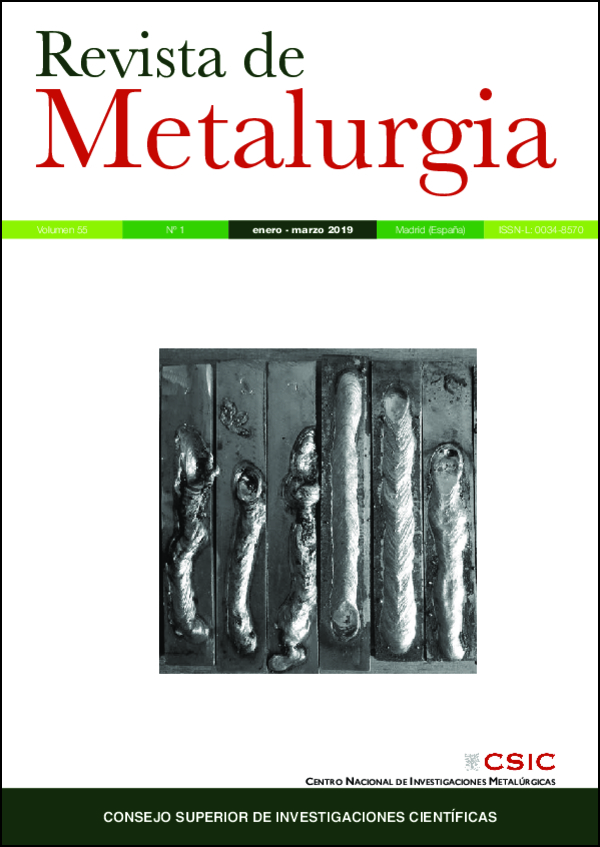Effect of cobalt on zinc oxide nanoparticles in the anticorrosive performance of an alkyd primer
DOI:
https://doi.org/10.3989/revmetalm.139Keywords:
Cobalt oxide, Corrosion, Corrosion protection, Nanoparticles, Solution combustion synthesis, Zinc oxideAbstract
The objective of this research was to study the inhibitory effect of CoO in ZnO obtained by solution combustion synthesis (SCS) when they are incorporated into alkyd formulations. ZnO and mixed oxides of the type Zn1-xCoxO (where x = 0.05-0.10-0.15-0.20) were obtained by SCS and characterized by XRD, ICP-OES, SEM and TEM. The pigments were incorporated into alkyd primers in three proportions, 5%, 10% and 20% by weight pigments / resin. Steel probes protected with the alkyd formulations were tested in salt spray and sulfur dioxide chambers. Likewise, the inhibiting efficiency of the pigments was estimated by electrochemical tests (Tafel method) in 0.1 M NaCl solution. The results showed that CoO improves the inhibitory properties of the ZnO based nano-pigments obtained by SCS.
Downloads
References
Abu Ayana, Y.M., El-Sawy, S.M., Salah, S.H. (1997). Zinc-ferrite pigment for corrosion protection. Anti-Corrosion Methods and Materials 44 (6), 381-388. https://doi.org/10.1108/00035599710367681
Ahmed, N.M., Selim, M.M. (2005). The effect of cobalt oxide on zinc oxide in a new anticorrosive green pigment. Anti-Corrosion Methods and Materials 52 (6), 353-364. https://doi.org/10.1108/00035590510624695
Ammar. Sh., Ramesh, K., Vengadaesvaran, B., Ramesh, A.K., Arof, A.K. (2016a). Amelioration of anticorrosion and hydrophobic properties of epoxy/PDMS composite coatings containing nano ZnO particles. Prog. Org. Coat. 92, 54-65. https://doi.org/10.1016/j.porgcoat.2015.12.007
Ammar, Sh., Ramesh, K, Vengadaesvaran, B., Ramesh, S., Arof, A.K. (2016b). Formulation and characterization of hybrid polymeric/ZnO nanocomposite coatings with remarkable anti-corrosion and hydrophobic characteristics. J. Coat. Technol. Res. 13 (5), 921-930. https://doi.org/10.1007/s11998-016-9799-z
Aruna, S.T., Mukasyan, A.S. (2008). Combustion synthesis and nanomaterials. Curr. Opin. Solid St. Mat. Sci. 12 (3-4), 44-50. https://doi.org/10.1016/j.cossms.2008.12.002
ASTM D 714-02 (2009). Standard Test Method for Evaluating Degree of Blistering of Paints. ASTM International, West Conshohocken, PA, USA.
ASTM D 610-08 (2012). Standard Practice for Evaluating Degree of Rusting on Painted Steel Surfaces. ASTM International, West Conshohocken, PA, USA.
ASTM B 499-09 (2014). Standard Test Method for Measurement of Coating Thicknesses by the Magnetic Method: Nonmagnetic Coatings on Magnetic Basis Metals. ASTM International, West Conshohocken, PA, USA.
ASTM D 562-10 (2014). Standard Test Method for Consistency of Paints Measuring Krebs Unit (KU) Viscosity Using a Stormer-Type Viscometer. ASTM International, West Conshohocken, PA, USA.
ASTM B 117-16 (2016). Standard Practice for Operating Salt Spray (Fog) Apparatus. ASTM International, West Conshohocken, PA, USA.
Cayton, R.H., Sawitowski, T. (2005). The Impact of Nano-Materials on Coatings Technologies. Technical Proceedings NSTI-Nanotech 2005. Vol. 2, Chapter 2, Nano Composites. https://www.nsti.org/publications/Nanotech/ 2005/pdf/829.pdf.
Dhoke, S.K., Khanna, A.S., Mangal Sinha, T.J. (2009). Effect of nano-ZnO particles on the corrosion behavior of alkyd-based waterborne coatings. Prog. Org. Coat. 64 (4), 371-382. https://doi.org/10.1016/j.porgcoat.2008.07.023
Dhoke, S.K., Khanna, A.S. (2009a). Effect of nano-Fe2O3 particles on the corrosion behavior of alkyd-based waterborne coatings. Corros. Sci. 51 (1), 6-20. https://doi.org/10.1016/j.corsci.2008.09.028
Dhoke, S.K., Khanna, A.S. (2009b). Electrochemical behavior of nano-iron oxide modified alkyd based waterborne coatings. Mater. Chem. Phys. 117 (2-3), 550-556. https://doi.org/10.1016/j.matchemphys.2009.07.010
Koleske, J.V. (1995). Paint and Coating Testing Manual. ASTM, 14th Edition, Philadelphia.
Patil, K.C. (1993). Advanced ceramics: Combustion synthesis and properties. Bull. Mater. Sci. 16 (6), 533-541. https://doi.org/10.1007/BF02757654
Patil, K.C., Aruna, S.T., Ekambaram, S. (1997). Combustion synthesis. Curr. Opin. Solid St. Mat. Sci. 2 (2), 158-165. https://ac.els-cdn.com/S1359028697800605/1-s2.0-S1359028697800605-main.pdf?_tid=82757472-ff56-449b-9b44-27e5ee7a5ca9&acdnat=1550661066_5b882c3caa43912be2f21454b4a9bf29.
Patil, K.C., Hedge, M.S., Tanu Rattan, Aruna, S.T. (2008). Chemistry of Nanocrystalline Oxide Materials. Combustion Synthesis, Properties and Applications. World Scientific, New Jersey. https://doi.org/10.1142/6754
Ramezanzadeh, B., Attar, M.M., Farzam, M. (2011). A study on the anticorrosion performance of the epoxy-polyamide nanocomposites containing ZnO nanoparticles. Prog. Org. Coat. 72 (3), 410-422. https://doi.org/10.1016/j.porgcoat.2011.05.014
Rashvand, M., Ranjbar, Z. (2013). Effect of nano-ZnO particles on the corrosion resistance of polyurethane-based waterborne coatings immersed in sodium chloride solution via EIS technique. Prog. Org. Coat. 76 (10), 1413-1417. https://doi.org/10.1016/j.porgcoat.2013.04.013
Rasouli, S., Danaee, I. (2011). Effect of preparation method on the anti-corrosive properties of nanocrystalline Zn-CoO ceramic pigments. Mater. Corros. 62 (5), 405-410. https://doi.org/10.1002/maco.201005758
USEPA (2000a). Cobalt Compounds. United States Environmental Protection Agency. Consulta: 20 de febrero de 2019.
USEPA (2000b). Chromium Compounds. United States Environmental Protection Agency. Consulta: 20 de febrero de 2019. https://www.epa.gov/sites/production/files/2016-09/documents/chromium-compounds.pdf.
USEPA (2018). Health Effects Notebook for Hazardous Air Pollutants. United States Environmental Protection Agency. Consulta: 20 de febrero de 2019.https://www.epa.gov/haps/health-effects-notebook- hazardous-air-pollutants.
Published
How to Cite
Issue
Section
License
Copyright (c) 2019 Consejo Superior de Investigaciones Científicas (CSIC)

This work is licensed under a Creative Commons Attribution 4.0 International License.
© CSIC. Manuscripts published in both the printed and online versions of this Journal are the property of Consejo Superior de Investigaciones Científicas, and quoting this source is a requirement for any partial or full reproduction.
All contents of this electronic edition, except where otherwise noted, are distributed under a “Creative Commons Attribution 4.0 International” (CC BY 4.0) License. You may read the basic information and the legal text of the license. The indication of the CC BY 4.0 License must be expressly stated in this way when necessary.
Self-archiving in repositories, personal webpages or similar, of any version other than the published by the Editor, is not allowed.
















